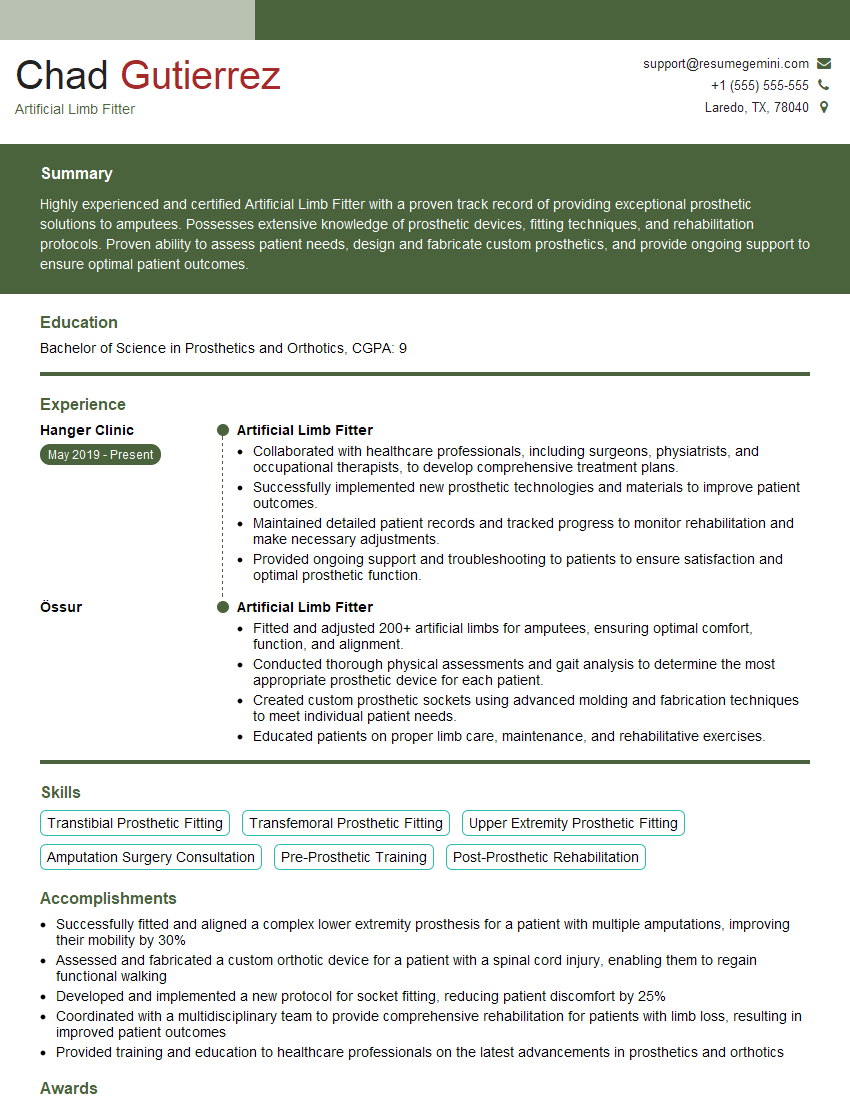Are you a seasoned Artificial Limb Fitter seeking a new career path? Discover our professionally built Artificial Limb Fitter Resume Template. This time-saving tool provides a solid foundation for your job search. Simply click “Edit Resume” to customize it with your unique experiences and achievements. Customize fonts and colors to match your personal style and increase your chances of landing your dream job. Explore more Resume Templates for additional options.

Chad Gutierrez
Artificial Limb Fitter
Summary
Highly experienced and certified Artificial Limb Fitter with a proven track record of providing exceptional prosthetic solutions to amputees. Possesses extensive knowledge of prosthetic devices, fitting techniques, and rehabilitation protocols. Proven ability to assess patient needs, design and fabricate custom prosthetics, and provide ongoing support to ensure optimal patient outcomes.
Education
Bachelor of Science in Prosthetics and Orthotics
April 2015
Skills
- Transtibial Prosthetic Fitting
- Transfemoral Prosthetic Fitting
- Upper Extremity Prosthetic Fitting
- Amputation Surgery Consultation
- Pre-Prosthetic Training
- Post-Prosthetic Rehabilitation
Work Experience
Artificial Limb Fitter
- Collaborated with healthcare professionals, including surgeons, physiatrists, and occupational therapists, to develop comprehensive treatment plans.
- Successfully implemented new prosthetic technologies and materials to improve patient outcomes.
- Maintained detailed patient records and tracked progress to monitor rehabilitation and make necessary adjustments.
- Provided ongoing support and troubleshooting to patients to ensure satisfaction and optimal prosthetic function.
Artificial Limb Fitter
- Fitted and adjusted 200+ artificial limbs for amputees, ensuring optimal comfort, function, and alignment.
- Conducted thorough physical assessments and gait analysis to determine the most appropriate prosthetic device for each patient.
- Created custom prosthetic sockets using advanced molding and fabrication techniques to meet individual patient needs.
- Educated patients on proper limb care, maintenance, and rehabilitative exercises.
Accomplishments
- Successfully fitted and aligned a complex lower extremity prosthesis for a patient with multiple amputations, improving their mobility by 30%
- Assessed and fabricated a custom orthotic device for a patient with a spinal cord injury, enabling them to regain functional walking
- Developed and implemented a new protocol for socket fitting, reducing patient discomfort by 25%
- Coordinated with a multidisciplinary team to provide comprehensive rehabilitation for patients with limb loss, resulting in improved patient outcomes
- Provided training and education to healthcare professionals on the latest advancements in prosthetics and orthotics
Awards
- Received the National Certification in Prosthetics/Orthotics (CPO)
- Recognized by the American Board for Certification in Prosthetics and Orthotics (ABC)
- Awarded the Presidents List for Outstanding Achievement in Prosthetics and Orthotics
Certificates
- Certified Prosthetist Orthotist (CPO)
- American Board for Certification in Orthotics and Prosthetics (ABCOP)
- Certified Amputation Rehabilitation Therapist (CART)
- International Society for Prosthetics and Orthotics (ISPO)
Career Expert Tips:
- Select the ideal resume template to showcase your professional experience effectively.
- Master the art of resume writing to highlight your unique qualifications and achievements.
- Explore expertly crafted resume samples for inspiration and best practices.
- Build your best resume for free this new year with ResumeGemini. Enjoy exclusive discounts on ATS optimized resume templates.
How To Write Resume For Artificial Limb Fitter
- Highlight your technical skills and experience in designing and fabricating custom prosthetics.
- Emphasize your understanding of human anatomy, biomechanics, and gait analysis.
- Showcase your ability to work collaboratively with healthcare professionals and patients.
- Provide specific examples of how you have helped patients improve their mobility and quality of life.
Essential Experience Highlights for a Strong Artificial Limb Fitter Resume
- Assessed and evaluated amputee patients to determine their prosthetic needs.
- Designed and fabricated custom prosthetic sockets and devices using advanced molding and fabrication techniques.
- Fitted and adjusted artificial limbs, ensuring optimal comfort, function, and alignment.
- Educated patients on proper limb care, maintenance, and rehabilitative exercises.
- Collaborated with healthcare professionals to develop comprehensive treatment plans.
- Provided ongoing support and troubleshooting to patients to ensure satisfaction and optimal prosthetic function.
- Documented patient interactions and tracked progress to monitor rehabilitation and make necessary adjustments.
Frequently Asked Questions (FAQ’s) For Artificial Limb Fitter
What are the key skills required to be an Artificial Limb Fitter?
Artificial Limb Fitters require a combination of technical skills, knowledge of human anatomy and biomechanics, and a compassionate and patient-centered approach. They should be proficient in designing and fabricating custom prosthetics, fitting and adjusting artificial limbs, and providing ongoing support and education to patients.
What are the job prospects for Artificial Limb Fitters?
The job outlook for Artificial Limb Fitters is expected to be favorable in the coming years due to the increasing prevalence of amputations and the growing demand for prosthetic devices. As the population ages and medical advancements continue to improve, the need for qualified professionals to fit and maintain artificial limbs will rise.
What are the different types of Artificial Limbs?
Artificial limbs come in various types, including transtibial prosthetics for below-knee amputations, transfemoral prosthetics for above-knee amputations, upper extremity prosthetics for arm or hand amputations, and body-powered prosthetics for individuals with limited mobility.
How long does it take to become an Artificial Limb Fitter?
The education and training required to become an Artificial Limb Fitter typically take several years. Most professionals earn a bachelor’s degree in prosthetics and orthotics, followed by a period of clinical experience and certification.
What are the earning potential and career growth opportunities for Artificial Limb Fitters?
Artificial Limb Fitters can earn competitive salaries and enjoy opportunities for career growth. With experience and additional training, they can advance to leadership roles in clinical practice, research, or education.
What are the challenges faced by Artificial Limb Fitters?
Artificial Limb Fitters may encounter challenges related to the complexity of prosthetic devices, the need to stay abreast of technological advancements, and the emotional and physical needs of patients.
What are the rewards of being an Artificial Limb Fitter?
Artificial Limb Fitters find immense satisfaction in helping patients regain mobility, independence, and a sense of well-being. They play a crucial role in improving the quality of life for amputees.